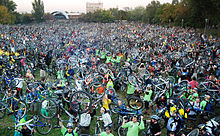For all that a third or more of Australians will admit they just don’t know enough about nuclear technology, plenty of the associated terminology has been casually welcomed into our language.
The Bomb
The ultimate symbol for human destructiveness which needs no other descriptors, and fortunately not used as a weapon of war for 70 years. What would our parents have thought if we could go back in time and tell them there’d be no nuclear escalation of the cold war after all? Sadly, there were more Japanese casualties in the entirely conventional Tokyo firebombing than at Hiroshima and Nagasaki.
Critical mass
 Either the required condition for a handful of specific isotopes to undergo an uncontrolled chain reaction, or a disruptive urban bike ride.
Either the required condition for a handful of specific isotopes to undergo an uncontrolled chain reaction, or a disruptive urban bike ride.
Fallout
Generally used to refer to the repercussions of a pivotal event or decision. It is also often used when talking about radiological release from nuclear accidents, though more correctly it specifies only contamination from weapons detonations. 100s of these were carried out last century, and the still-measureable fallout has not had any measurable impact human health.
Meltdown
This is what kids do. Considering the comparative frequency and likelihood, the expensive, reactor-core destroying version could be named after the temper tantrum instead of vice versa. Three Mile Island 2 was the first major example and it proved the effectiveness of US-style Defence in Depth. If The China Syndrome comes to mind, just remember that the film was realistic enough that the reactor shut down perfectly, safely and repeatedly.
Nuke
This is using a microwave to heat food, which is perfectly safe. It is also now what nuclear professionals are called in the US.
Half-life
A computer game which has nothing to do with its namesake, but that’s ok. Half-life is an easy concept, but it gets counterintuitive when you consider that radioisotopes with longer half-lives generally present less hazard, not more.
Fuel rod
This only really refers to one thing, the zircalloy clad solid ceramic fuel designed for pressurised and boiling water reactors. Safe to handle when fresh, way too hot to steal or interfere with after 3 years in a reactor, and completely different to the material required for weapons in both cases, most people still vaguely know what a fuel rod is.
Atomic (& the atom symbol)
Perhaps a bit old-timey, “atomic” is still used by enthusiasts and professionals. While the trefoil – the symbol for radiological hazard – has been co-opted and abused by hysterical activists as a visual trigger, the atom symbol pops up widely as a more pure symbol of science and technology in general. And also where this beneficial connotation might aid marketing.
My next post will be my last for a while. With quite a bit of other work to do – and do well – in addition to a speculative science fiction novel well under way, there’s insufficient time to supply new useful analysis and commentary on this blog. My ABC Radio National article can still be accessed here, my one at The Energy Collective here, and there’s around a hundred archived posts here for interested readers. I also recommend the archived analysis at DecarboniseSA, and TCASE at Brave New Climate. I’ll be reachable on Twitter, as always.



The China Syndrome did not depict any failures of technology. It did play on the issue of (at the time) lax security which obviously has changed, and also cover up of what arguably was a sloppy QA program. I doubt if today’s QA programs would have such issues. If nothing else, they are overly restrictive, elevating minor issues to what appear to the uninformed public to be major issues.